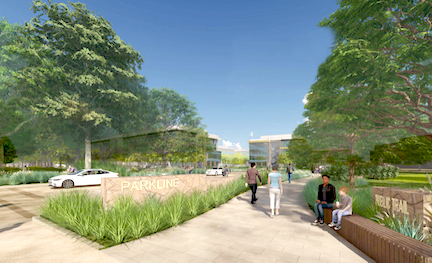
BY SARA TABIN
Daily Post Contributor
SRI has upped the housing in its Parkline Project to 800 units, according to plans under consideration by the city of Menlo Park. But a decision to put the lowest income units in a separate building from the rest has drawn criticism.
The Stanford Research Institute wants to redevelop its 63-acre campus at 333 Ravenswood Ave. by demolishing 36 of 39 existing buildings and creating new buildings for offices, homes, and retail. About 1,100 people currently work at the campus, but SRI is allowed up to 3,308 employees through an agreement with the city.
Plans for the new project call for 1.38 million square feet in office or R&D space. Assuming one employee would take up 250 square feet of space, the project would have room for 5,500 workers.
Lane Partners, the developer hired by SRI, originally submitted the project to the city in October 2021. The city’s planning commission criticized the previous proposals of 400-550 units for not offering enough housing. In response, the SRI increased the number of units to 800, which includes both apartments and townhouses.
Of the 800 units, 154 units would be 100% affordable “and/or special needs” housing while another 97 would be slated as low-income housing. The proposal does not specify what income limits are attached to the housing or what would qualify as a disability.
The 154 completely affordable units would be separated in their own six-story building which would be developed by an affordable housing developer rather than Lane Partners.
Resident Phillip Bahr questioned the separation of the affordable units in a letter to city council.
“Placing all affordable housing and/or special needs in one building at the corner of Middlefield and Ravenswood sends the wrong message to those households and the community,” he wrote. He said the message is one of separation rather than inclusion. “The concept of housing separation by economic levels is hurtful and did not meet a happy ending during the 1960s and 1970s.”
A mix of studio, one-bedroom, two-bedroom, three-bedroom, and four-bedroom units are included in the project. Townhouses are set up to buffer one of the apartment buildings and the single-family homes in the nearby Classics of Burgess community.
The office and retail buildings would have 2,800 parking spaces while the housing units would get 919. Green space including a dog park and playground are included in the project.
If the project moves forward as proposed, 768 trees will be removed. Another 860 trees would be planted as part of the project.
Resident Marlene Santoyo, a member of pro-housing group Menlo Together, wrote a letter to the council urging them to move forward with the current project design. She said the open space looks beautiful and praised the inclusion of both market-rate and affordable housing.
“There is no better place to add new homes than within walking distance to Burgess Recreation Center, downtown shops and restaurants, the Menlo Park Library, Caltrain, and bus lines,” wrote Santoyo. “I wish we could have reduced the amount of space dedicated to parking cars, but for some in our community that will be reassuring.”
The SRI is not part of Stanford University. It advertises itself as an independent nonprofit researching everything from AI to education. Although the Menlo Park location is the group’s headquarters, it has a location in Tokyo as well as multiple locations across the United States. Companies, nonprofits, and government organizations can hire the SRI to do research for them.

Candidates only say they care about housing at election time. We don’t need more offices. We need more homes. I hope City Council doesn’t squander this opportunity.
Why does this project allow any commercial office space? It doesn’t make any sense. City council is looking to cram dense housing into our family neighborhoods and they’re missing this opportunity to add housing without disrupting the citizens who are already paying taxes. And what about all of the empty office space on the Peninsula???